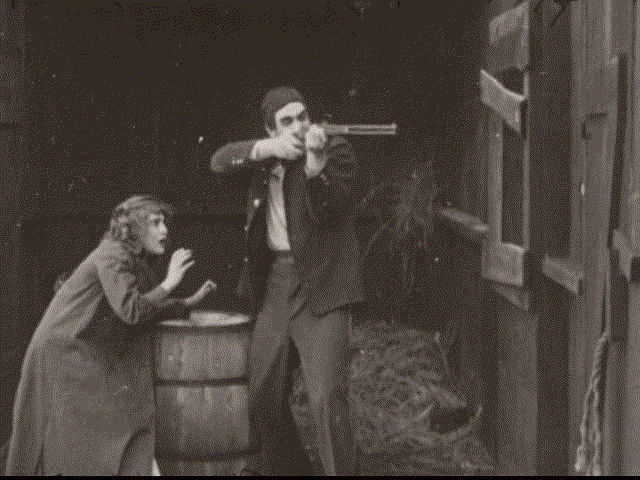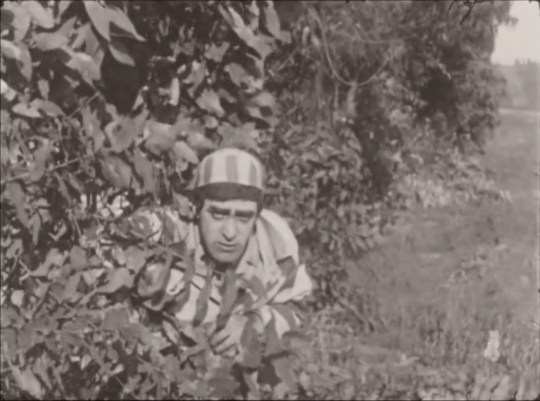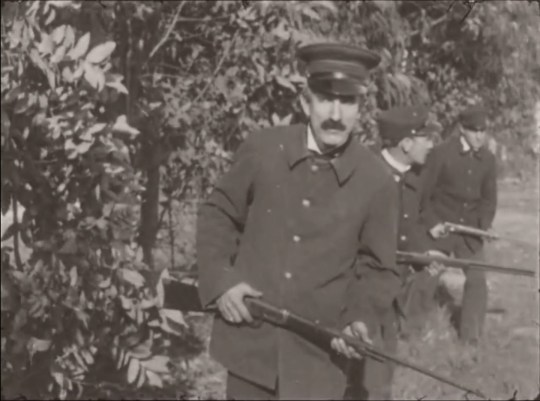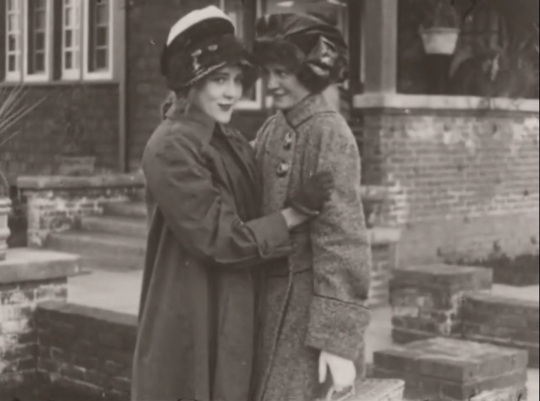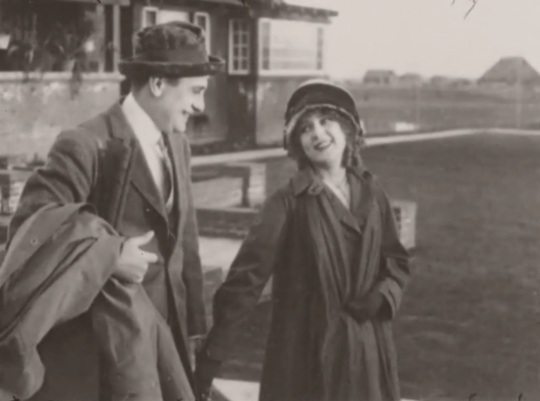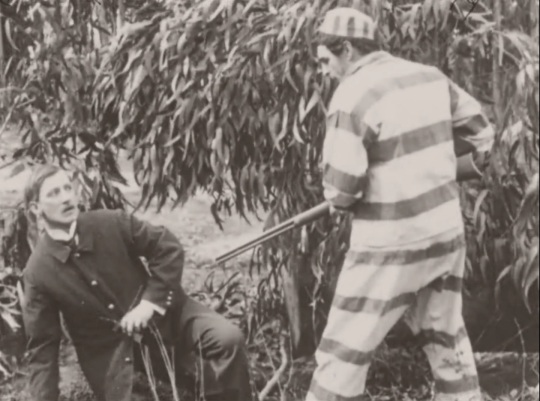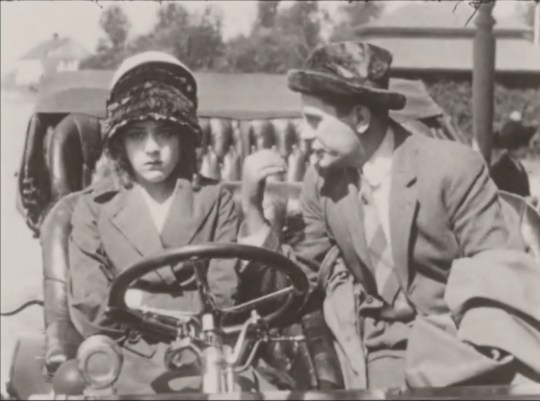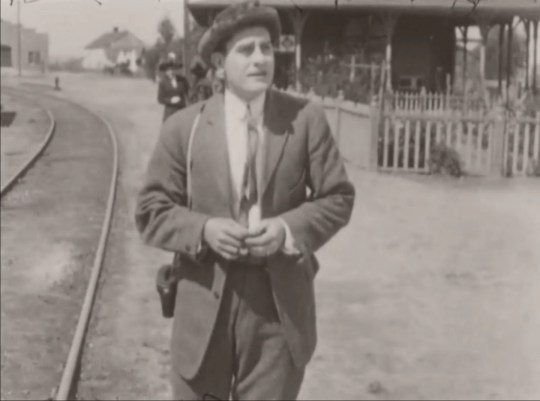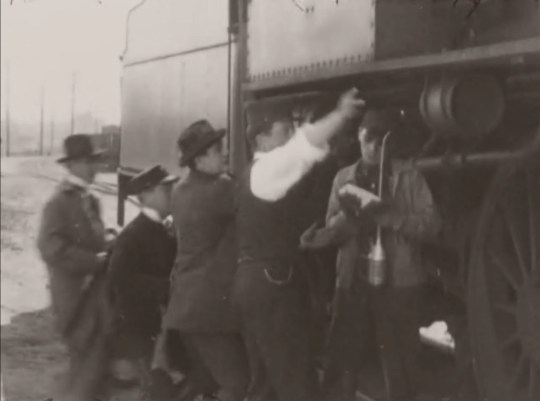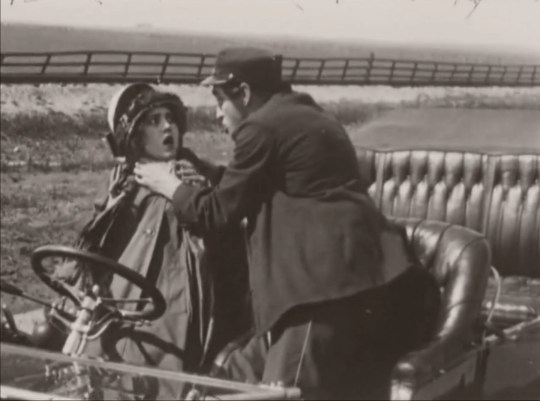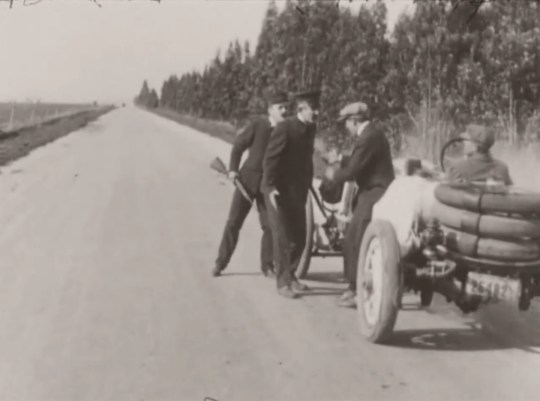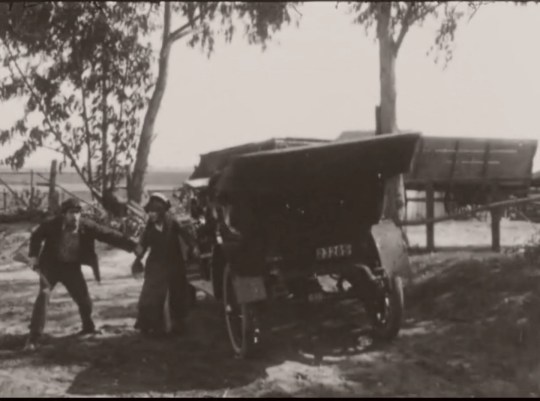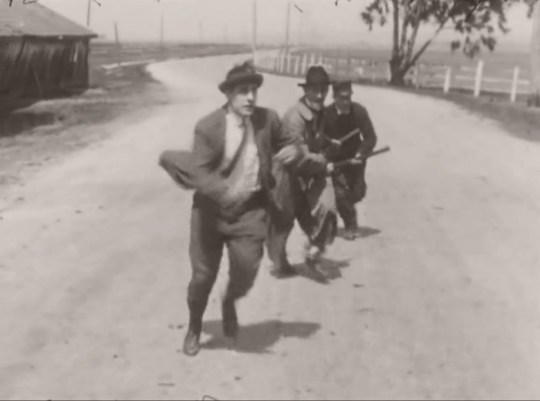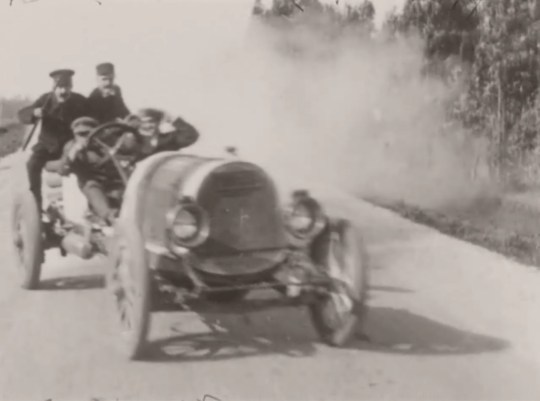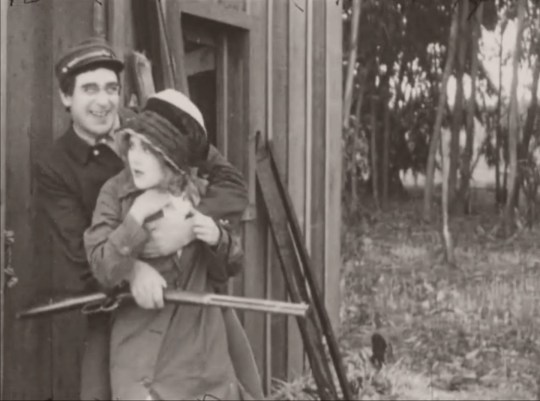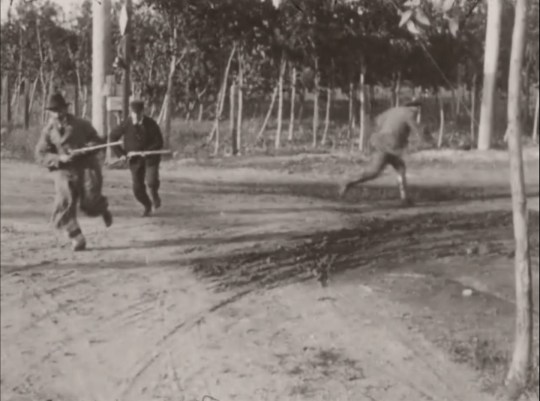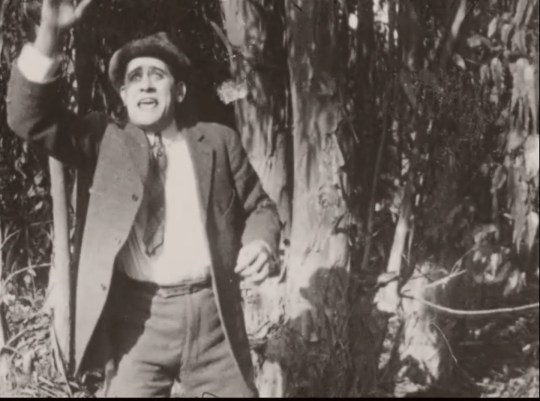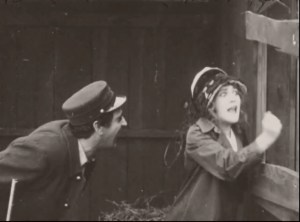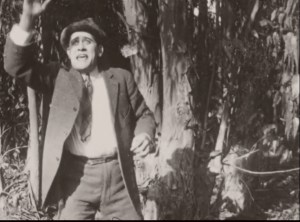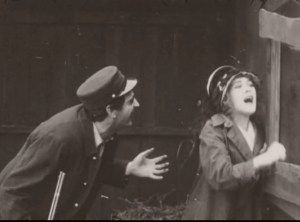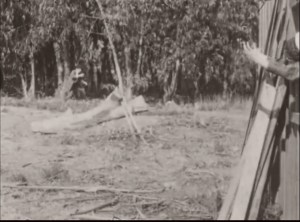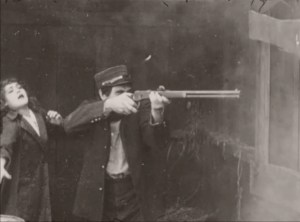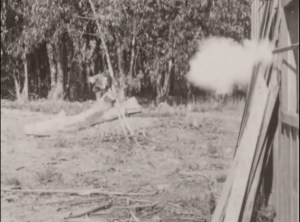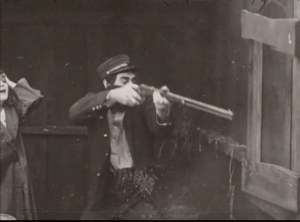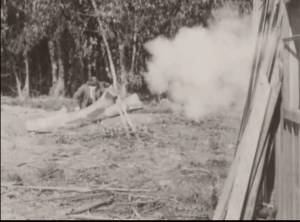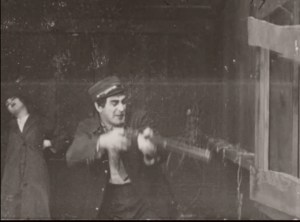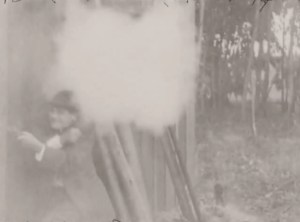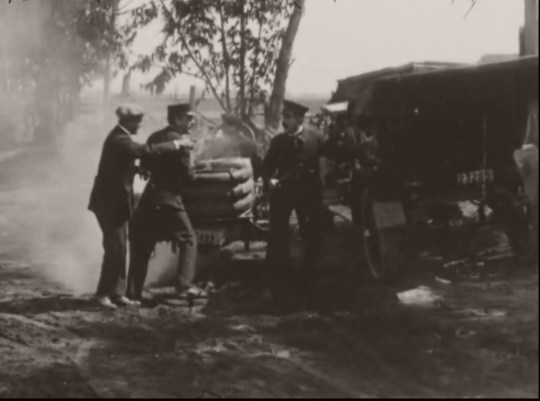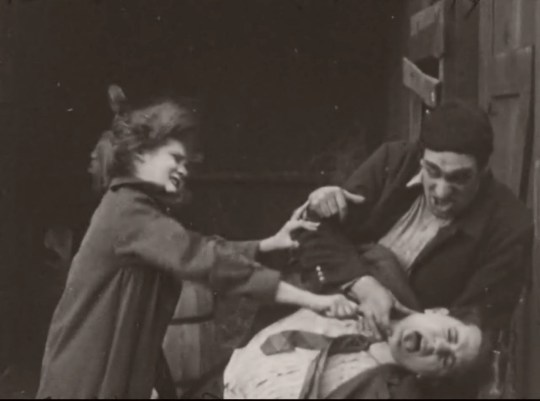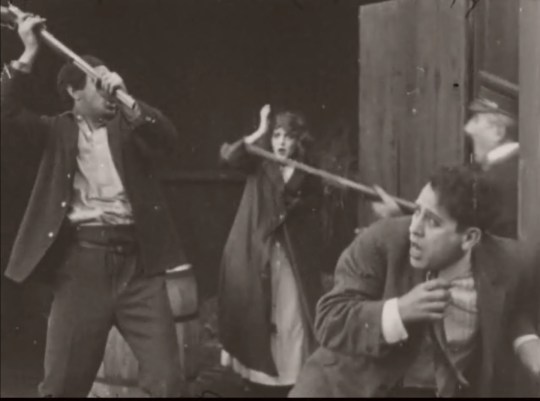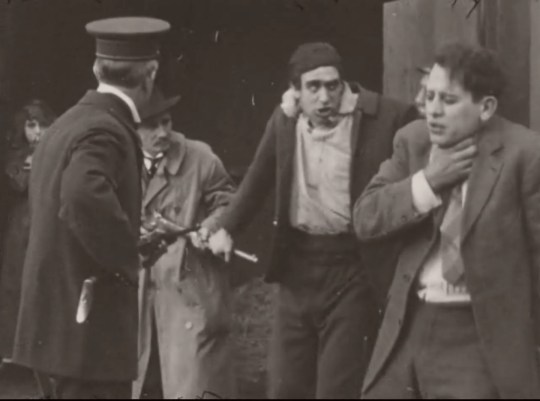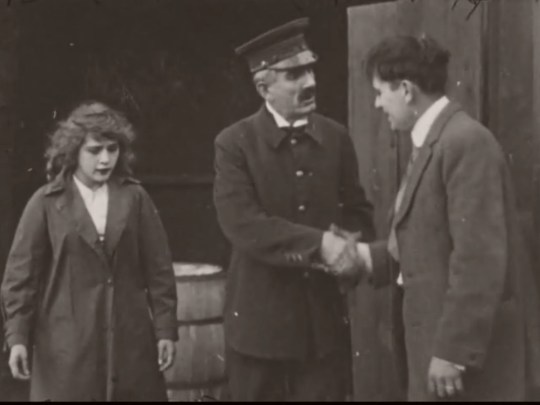Speed Thrills.
Abducted and held hostage by an escaped convict disguised as a prison guard, Edith (Mary Pickford) helps her “coward” boyfriend (Edwin August) pass a true test of courage under duress in A Beast at Bay (Biograph, 1912, directed by D.W. Griffith).
* * *
One of the charms of the single reel drama — a complete story arc in less than fifteen minutes — was also one of the biggest challenges for early filmmakers. The format is inherently limiting. Principal characters — their nature and motivation — must be established immediately. There is little or no room for a backstory, or digression. With a plot often racing at breakneck speed (hence the popularity of the chase or rescue genre), dramatic evolution of a main character might be delayed until the climactic moments, within the last hundred feet of the reel.
Such challenges have led many to argue that the short film was best suited to comedy, especially physical comedy where story and character development were not essential. It is an argument that persists to this day. But those filmmakers who found success in the short drama could deliver as much dramatic interest as might be seen in a modern, hour-long television production. And they did it without relying on dialog intertitles, which were uncommon during the peak years of the single reel drama — roughly 1908 to 1913 — before features became the dominant format.
In A Beast at Bay, we have four “acts” in miniature. We get the characters and a sample of their personalities in the first three scenes, only one of which lasts more than 60 seconds, constituting a “first act.” The second act provides the spur to action — an abduction. The third, a high-speed pursuit. And in the fourth, a clash of opposing forces ending well for two of the three principal players. We even get a tender epilogue.
For Mary Pickford, 1912 marked a return to her cinema roots. She had departed Biograph at the end of 1910 and joined Carl Laemmle’s Independent Motion Pictures (IMP) company. She gained the star publicity denied her at Biograph, but coupled with a star-crossed marriage to Owen Moore, it turned out to be the lowest point of her film career. The contract with IMP was nullified in court after less than a year — Pickford had signed it while still a minor — and after a brief, unpleasant and ultimately unsuccessful stint with the Majestic company, she returned to her first film family at Biograph.
A Beast at Bay was another sort of return-to-roots for Pickford. One of her first screen appearances had been The Lonely Villa (June, 1909), a suspense film propelled by a fast and furious ride-to-the-rescue sequence. Although “Beast” featured tracking shots of a car and a roaring locomotive, it wasn’t exactly revolutionary even for Biograph– Griffith and Bitzer had filmed a race on the rails in The Girl and Her Trust just weeks earlier.
What may have been intended as a difference-maker in A Beast at Bay was the addition of a third element to the chase — a racing car commandeered by the lawmen to aid them in pursuit of Pickford and her abductor. (Automotive racing had recently become a “thing” in the States — the inaugural Indy 500 race was held a year earlier). However, this proves to be superfluous to the main action, adding little more than a nice shot of the racer briefly becoming airborne over a hump in the road (though predating the famous shots in 1968’s Bullitt by more than a half century).
A Beast at Bay was shot on location during the Biograph company’s third annual winter excursion to Southern California. Completed in March (the exact dates and specific locations are not recorded), the film was released the 27th of May, 1912, at a length of 998 feet (304 meters), a single full reel.
* * *
The source for the images of A Beast at Bay is the digital access copy at the Library of Congress website, downloaded at 1080p, reduced here to 480p in the video edits to conserve file space. Because the image quality of the LOC source is dim and tonally flat, I gave a small boost to the contrast, and slightly increased the “color” temperature (which adds a faint sepia tone) to give a little depth to the image. (Please bear in mind that I’m using this material to discuss the film’s construction, direction and performances, and not an analysis of the cinematography or a critique of the quality of the LOC source, in which case I would have left the images as I found them.)
Of course the quality pales in comparison to a transfer made from the original camera negatives or early generation source material. The gorgeous video clips at the Mary Pickford Foundation website give us a brief but revealing look at what could be. [Unfortunately, the pristine, 8 minute clip from A Beast at Bay at the Mary Pickford Foundation website is no longer available online as of September 2020.]
A Beast at Bay contains 95 shots or “cuts,” plus 10 intertitles. Though not all of the shots are represented here by an image, all of the intertitles are reproduced in text at the appropriate points, in all-capitals within quotation marks.
The intertitles do not give proper names for any of the characters, simply referring to them as “the girl,” “her ideal” or “the convict.” The Biograph Bulletin plot synopsis, also reproduced in excerpts and quoted in italic within brackets [“…”], refers to the couple as “Edith” and “Jack.” For the sake of clarity so will I.
* * *
[The Biograph Bulletin: “A dangerous convict has escaped from prison and is skulking through the woods, pursued by prison officers.”]
A Beast at Bay opens not with an introductory intertitle, but with a moody shot of an escaped convict (Alfred Paget). He emerges slowly, carefully, from the dense vegetation and scans the area for signs of his pursuers, a troop of well-armed prison guards intent on his capture.
[“The officers separate and go in different directions in the hope of heading him off.”]
“HER IDEAL”
A blunt intertitle precedes our introduction to a beaming Edith (Mary Pickford), eyes caressing “her ideal” man, Jack (Edwin August). She confides in a friend (Mae Marsh) her attraction to Jack as the two gaze upon the object of Edith’s desire. We don’t know the exact nature or length of their relationship (unless we’ve cheated and read the Biograph Bulletin). Edith leaves the side of her friend and walks quietly, unseen, to Jack who is packing his golf clubs (or is he an angler packing his rods?) in final preparation for an out-of-town trip.
Jack turns to pick up his travel trunk and sees Edith. Both smile broadly. As Jack lifts the heavy trunk, Edith places her hand on his and they carry the trunk together, walking toward Edith’s car.
[“Edith is accompanying her sweetheart Jack to the railroad station in her auto”]
That’s correct. It is 1912, and Edith owns and drives, quite skillfully, a large, five-seat touring car, a beastly machine. And Edith is driving Jack to the train station.
“HIS REFUSAL TO MIX UP IN A STREET BRAWL
STAMPS HIM A COWARD IN HER EYES”
As they reach the car, a belligerent drunk approaches and begins to gesture rudely, mockingly, toward Jack. (He seems to be especially offended by Jack’s appearance, one of wealth and sartorial good taste). Jack tries to ignore him, keeping his back to the man, but he is clearly uncomfortable. The drunk becomes more abusive, and appears to challenge Jack to step into the street and take him on.
Jack remains impassive, but his face betrays a growing embarrassment and humiliation. As a final act of aggression, the man kicks the tire of Edith’s car. Seeing no response from Jack (or, just as likely, needing another drink), he hurls a few final insults, then turns away and stumbles back into the street.
During the episode, Edith’s expression is at first puzzlement, then irritation at Jack’s passivity, particularly after the man challenges Jack. Edith looks at the man, then at Jack, awaiting some kind of response. (A modern audience — and maybe even one in 1912 — would cheer if Edith decided to take matters into her own hands, although that would have been a severe blow to male pride, disastrous for a man’s reputation, and totally wreck the plot of the film.)
When Edith seeks an explanation for his inaction, Jack makes a feeble effort to defend himself. He wags his thumb over his shoulder dismissively, implying that the matter wasn’t worth escalating to the point of physical confrontation with a drunken bum. Edith briefly but pointedly makes her disappointment known, then walks to the car. She turns the crank, hops into the driver’s seat, releases the brake, puts the beast in gear, and they’re off to the train station.
The convict has captured the captain of the guards, forcing him at gunpoint to exchange clothing.
“I THINK YOU ARE A COWARD”
[(Edith) leaves in a huff, calling him a coward for not having entered into a street brawl with (the) drunken tramp who insulted them on the way . . .”]
As they pull into the train station, Edith is still brooding over the incident. In the clip below, she can be seen clearly saying the words, “Coward,” and “Goodbye” to Jack.
[“Jack has some time to wait before train time, and, upon looking after the departing auto, is surprised to see it held up by the disguised convict . . .”]
“THE CONVICT FORCES THE GIRL TO AID HIM TO ESCAPE”
Edith pulls over to the berm after she spots a large piece of cloth along the road. In hindsight, an extremely poor decision. The convict surprises her when he appears out of the weeds. But Edith, thinking the man in uniform is an officer of the law, isn’t concerned — until he brandishes the guard captain’s carbine in her face, forcing her back into the driver’s seat to enable his getaway. (A strange world, indeed, where an adult male criminal is clueless about cars and must depend on a young female hostage as his “wheel man.”)
From the train station, Jack observes Edith’s vehicle departing. Then, in a series of 11 shots (excluding the intertitle) alternating between Jack at the station and Edith’s car, we witness the abduction from what is intended to be Jack’s point of view. The first two shots of the sequence show Edith and the convict at the rear of her car, matching the direction in which the car had traveled, i. e., away from Jack and the train station.
But when Edith and the convict get into her car, Jack uses binoculars to get a better view. Aided by the binoculars, Jack’s POV does the impossible: it shifts to a view of the front of the car. The car hasn’t moved and neither has Jack, yet his point of view has. Something we take for granted, the matching of cuts in a point-of-view sequence, has yet to be made standard in 1912 (at least for Griffith and Biograph).
As the lawmen arrive on the scene and inform Jack that Edith’s abductor is an escaped convict in police uniform, the captain uses Jack’s binoculars with the same mismatched results.
As Jack and the lawmen observe the car pulling back onto the road — the POV shifts once more, to the rear of the car as it pulls away. The situation is dire: neither the lawmen nor Jack have access to a car, and every minute that passes is another mile lost.
“KNOWING THE TRACK TO RUN PARALLEL WITH THE ROAD, HE ATTEMPTS TO SECURE AN ENGINE FOR PURSUIT”
Their only hope of catching the car is to commandeer a train engine to follow along the tracks that run parallel to the roadway. When they are rebuffed by the locomotive’s engineer, they prevail upon the train dispatcher to reassign the engine for police work.
“HER RUSE UNSUCCESSFUL”
Edith tries to take advantage of her abductor’s ignorance of the horseless carriage — she slows and stops the car, pretending it has broken down. He calls her bluff by wrapping his hands around her neck and squeezing. She gets the message and, miraculously, the car is just fine and back on the road.
But now . . . they are being pursued.
“OTHER GUARDS ON THE TRAIL”
Two of the guards stop a racing car whose occupants tell them that they have seen two people in a car matching the description given by the guards, traveling in the opposite direction. The guards enlist the civilians to drive the racer in the pursuit.
“TO COVER HIS TRAIL, HE TAKES THE GIRL WITH HIM”
The convict decides to abandon the car, apparently to distract the attention of his pursuers, throwing them off the trail and perhaps buying a little more time while he heads in another direction: into the woods, taking Edith as hostage.
But still pursued by Jack and the guards, now on foot . . .
. . . and by more guards in the racer.
The convict finds cover and a place to make his stand with a human shield, Edith.
Having found the abandoned car, Jack and the guards split up to search the woods .
“HUH | YOU WITH YOUR SILK CURLS AND FINE CLOTHES,
ME STRIPED CANVAS”
Edith is trapped and at the mercy of this leering psychopath. He clearly enjoys being in a position of power over her — his words show that he appreciates the delicious irony of the situation. He is mocking her and her wealth that buys beautiful clothes and hairstyles while he has worn prisoners’ stripes. He mocks her as the drunken tramp mocked Jack for his trappings of wealth. But unlike the tramp, he is not a pathetic, stumbling, mumbling drunk — he’s psychotic and he has a gun. He won’t tire of the game and simply go away. Edith can’t turn her back and pretend he doesn’t exist. He holds the power of life and death over her.
The scene begins with a medium-close shot (i. e., from the knees to head), probably dictated by the close quarters of the shack. (Was it shot on a set in LA , or on location? There is no record.) Now fixated on Edith, the convict seems to have forgotten his pursuers. He backs Edith against a wall, touches her hair and lifts the hem of her coat to see what is underneath. The tension escalates then reaches a climax with an abrupt cut in mid-scene to a shoulders-to-head closeup of the convict in a terrifying, psychotic meltdown. Edith’s screams in reaction are heard far outside the tiny shack.
It is one of the rare uses of a closeup for purely dramatic purposes in the Griffith-directed Biographs, considering the credit he was once given for the invention and/or integration of the shot as a standard cinematic device. Regardless, it works. The moment gives us a significant jolt.
Jack cries out in response to Edith’s screams, rousing the convict from his fixation with Edith. His prisoners’ instinct for survival kicks in and Jack now becomes target practice for the con and his confiscated carbine.
“A REAL TEST”
Jack summons all of his unspent courage and begins to crawl forward like a besieged infantryman emerging from a trench, taking deadly fire head-on but determined to reach his objective.
Beginning with the last shot prior to the intertitle (which I’ve removed in order to concentrate on the shots), we are given a series of cuts alternating between the interior of the shack with Edith and the convict, and the exterior with Jack.
But in the construction and editing of this sequence, modern conventions of film “grammar” for alternating POV shots or “reverse angle” shots — requiring the matching of sight lines or “eye-lines” — aren’t followed here, at least not consistently. Though the effect is not as bizarre as the earlier POV shots at the train station, it renders this sequence slightly confusing or disorienting to the modern viewer.
Below, the first pair of shots basically follows “modern” convention, as the line of sight between the Edith and Jack matches, more or less. It’s not perfect (Jack is looking upward while Edith looks straight ahead), but it still works.
In the next pair, below, the first shot is is practically unchanged. But the second shot shows Edith’s arms at right beckoning out the window toward Jack at left. Jack is now looking to our right toward Edith and the shack instead of looking to our left as he was in the first pair of shots. That violates the sight-line established in the first shots of both pairs, where Edith is looking to the right of the frame. Our brains have to pause for a millisecond to figure out exactly how these images relate to each other. It’s just long enough to cause confusion as we try to keep track of the sequence of events.
In the next pair, immediately above, the second shot again is non-matching. The only difference is that instead of Edith’s arms, we see the barrel of the carbine as the convict fires at Jack, who is still looking right from the left of frame. And immediately below, the mismatch is repeated . . .
. . . until, immediately above, Jack reaches the shack, shown in the second shot from a new angle. The sight-lines now match, and Jack, through a thick haze of gun-smoke, is about to enter the door and meet his opponent face to face.
The racers and the remainder of the guards arrive at the site of Edith’s abandoned vehicle.
But the struggle is not going well for Jack and Edith, as the convict tosses Jack around like a rag doll . . .
. . . until, in the nick of time, the guards reach the shack . . .
. . . and disarm and subdue the convict.
Jack and Edith, though worse for wear, are fine . . . and relieved.
The guard captain thanks Jack for his bravery . . . and Edith apologizes for ever doubting his courage.
* * *
The Biographs in the Griffith/Bitzer era (1908-1913) were filmed at a variety of speeds, some well below the 16 frames per second that became a de facto industry standard by the end of that period. Even within films, Bitzer (and maybe Arthur Marvin too) cranked or “under-cranked” his Biograph camera at various speeds — 16 fps for some scenes, 14 or 12 for others.
The effect when projected onscreen at a (more or less) steady 16 fps would be to “speed-up” those sequences of film that had originally been shot at less than 16 fps. In some films — A Beast at Bay appears to be one of them — the intent was to create contrast, to increase the pace in comparison with other scenes and thus raise the excitement level in a melodrama, which is what A Beast at Bay was considered at the time of its original release. (Today, we would probably assign a film with the same basic plot to the “suspense” or “action-film” genre.)
In his feature film years, Griffith issued “instructions” for exhibition that asked projectionists to speed up or slow down during specified scenes. Such instructions were likely heeded only during first-runs in large cities, if at all. In the Biograph years it may have made more sense — and was certainly less difficult — to shoot single reel films at varying speeds in order to achieve the desired effect, rather than expecting a nickelodeon operator to follow a speed “script.”
The streaming video of A Beast at Bay on the website of the Library of Congress is obviously derived from a 16 mm “access” copy of the 35 mm paper print deposited for copyright purposes in 1912. (It is definitely not from the camera negatives Mary Pickford donated to the LOC — but at least it is in correct continuity!)
This digital transfer of the film runs a whopping 17:53, including 14 seconds for the LOC intro/outro voice-over. At this speed the film seems to drag, most notably during what should be the highlight of the film, the chase sequence. I don’t know if this was an artifact of the duplication of the paper prints to 16 mm film in the 1960s, or if it was a choice made in the digital transfer. But a run time of nearly 18 minutes is too slow for this single reel “suspense” film.
Calculated using the standard film speed formula, 998 feet of 35 mm film projected at the “silent standard” of 16 fps will result in a run time of just under 17 minutes. So, from a purely technical standpoint, a run time between 17 and 18 minutes is not far from “correct.” However, my personal taste, especially for the “action” sequences, is about 20% faster.
The video clips used to illustrate this article are presented at speeds that simulate film projection at a range of about 18 to 20 frames per second, closer to, but still well under modern “sound speed.” Although I did this only for select scenes, I find the entire film plays better at around 13 to 14 minutes.
And if you are curious, the clip of A Beast at Bay at the Mary Pickford Foundation website — an excerpt that begins with Edith parking her car at the side of the road just prior to her abduction and ends with the hug near the end of the film — runs just over eight minutes (8:09). That same sequence in the LOC website source runs eleven and one-half minutes (11:30).
[NOTE: The pristine, 8 minute clip from A Beast at Bay at the Mary Pickford Foundation website is no longer available online as of September 2020.]
I did not do a frame by frame comparison, but the faster run time of the MPF excerpt when extrapolated for the entire film produces a total duration of just over twelve and a half minutes (12:31), compared to 17:39 for the LOC source without the LOC intro/outro). That may be slightly fast, but it’s much closer to my concept of a reasonable run time for this film.
* * *
In The Archives . . .
Primary sources of A Beast at Bay are held at the archives of several institutions. In the archives of the Library of Congress alone, the survey by Christel Schmidt tallies eleven film elements for A Beast at Bay, with considerable variation in length, format and condition.
Another large collection of primary sources for A Beast at Bay appears to be the British Film Institute National Film and Television Archive, with six 35 mm film elements, including four duplicate negatives and two access copies listed on the BFI website. Four of the six range in length from 926 to 964 feet.
Also, it should be noted that the Schmidt survey of BFI holdings lists five additional sources at that institution, including four nitrate master positives (two of which are “badly decomposed”), and an additional access copy. The entry for A Beast at Bay in “The Griffith Project, Vol. 6” (BFI, 2002), also lists a “35 mm nitrate positive (printed 1920),” at the BFI, but as of February 2019, the BFI website does not list this item in their collection. However, it may be one of those four nitrate positives that Schmidt cited.
“The Griffith Project, Vol. 6” reports a “28 mm diacetate positive” at The Museum of Modern Art in New York, and “two 16 mm acetate positives of undetermined generation” at the National Archives of Canada .
The Mary Pickford Foundation Collection at the UCLA Film & Television Archive lists (as of 2013) a 16 mm safety print of A Beast at Bay.
* * *
What the Trade Papers Said . . .


The Biograph advertisement for A Beast at Bay characterizes the story as “A Convict’s Wild Dash for Liberty,” a more accurate a description than the title. This particular “beast” was never really held “at bay” until handcuffed at the film’s end.
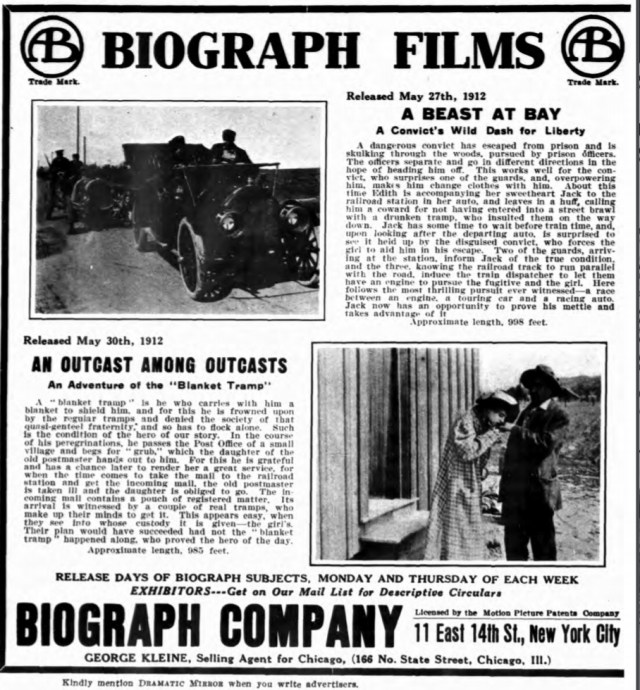
* * *
Primary Sources:
The Library of Congress, Digital Collections, National Screening Room, A Beast at Bay;
Christel Schmidt, at pickfordfilmlegacy.tripod.com, a survey of the archival Pickford holdings by FIAF member institutions in the United States and Europe;
The Mary Pickford Foundation for the eight minute excerpt from A Beast at Bay.
lantern.mediahist.org for The Moving Picture World, April –June 1912, Review, A Beast at Bay, June 8, 1912, p. 944;
fultonhistory.com for The New York Dramatic Mirror, Sep 1911 – Dec 1912), Review, A Beast at Bay, June 5, 1912, p. 28, and Biograph advertisement, June 3, 1912.
Bibliography:
Ben Brewster, “A Beast at Bay,” pp. 57-60, The Griffith Project, Volume 6, Films Produced in 1912, Paolo Cherchi Usai, General Editor, BFI Publishing, 2002;
Paolo Cherchi Usai, Silent Cinema: An Introduction, (BFI, 2000); for discussion of silent film speed, and film preservation/restoration;
Cooper C. Graham, Stephen Higgins, Elaine Mancini, Joáo Luiz Vieira, D. W. Griffith and the Biograph Company (Filmmakers, No. 10), (The Scarecrow Press, 1985), “A BEAST AT BAY,” p. 144, for cast and credits.
